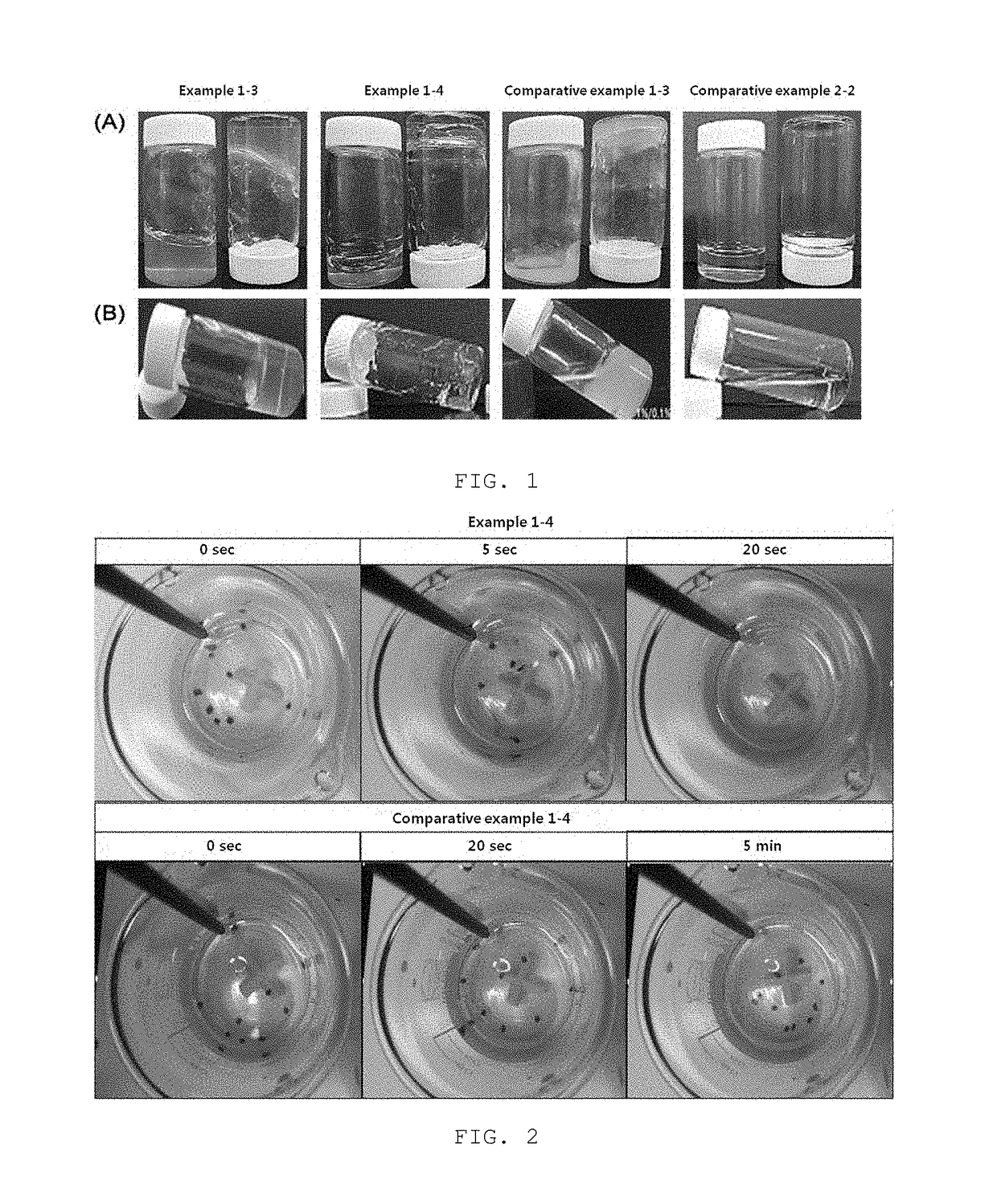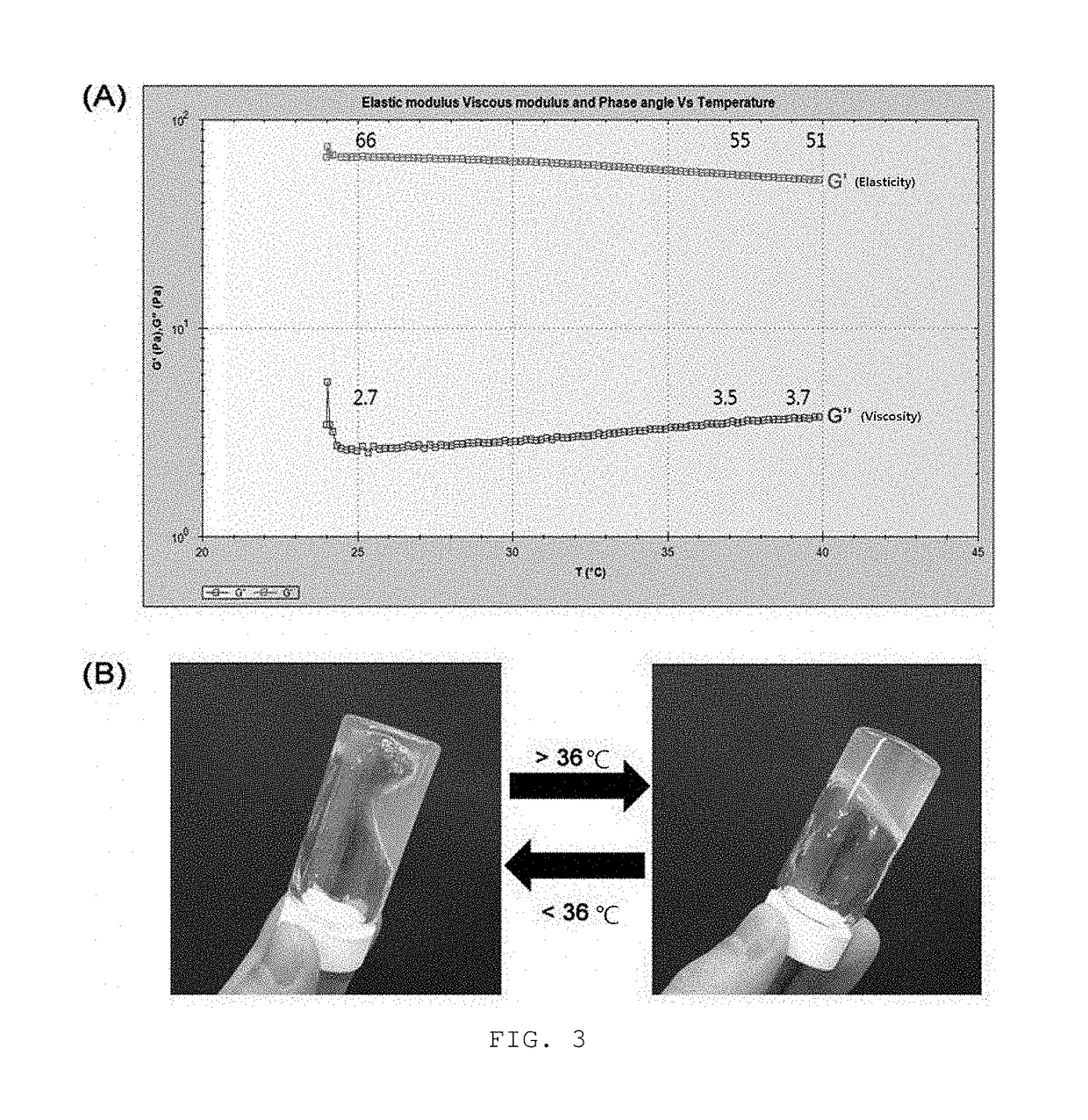Temperature sensitive hydrogel composition including nucleic acid and chitosan
a technology of temperature-sensitive hydrogels and compositions, which is applied in the direction of pharmaceutical non-active ingredients, pharmaceutical delivery mechanisms, organic active ingredients, etc., can solve the problems of lack of drug persistence, collapse of structures, and inability of dna hydrogels to properly perform the roles of artificial tissues and drug carriers, so as to increase the time for drug persistence and ensure the effect of drug efficacy, the effect of excellent biocompatibility and biostability
- Summary
- Abstract
- Description
- Claims
- Application Information
AI Technical Summary
Benefits of technology
Problems solved by technology
Method used
Image
Examples
example 1
Production of Nucleic Acid-Chitosan Hydrogels
[0056]For the production of nucleic acid and chitosan hydrogels, nucleic acid and chitosan stock solutions were prepared with concentrations corresponding examples shown in table 1 below. Here, nucleic acid was put in a buffer solution of 200 mM sodium phosphate dibasic dodecahydrate, and then dissolved therein using a heat stirrer at 65° C. for 1 hour.
[0057]In addition, chitosan was dissolved using 100 mM acetic acid.
[0058]The nucleic acid and chitosan stock solutions prepared with the concentrations in table 1 below were mixed at a weight ratio of 1:1, and stirred in a heat stirrer at 60° C. for 1 hour. Thereafter, the temperature was lowered to room temperature, followed by stirring for 1 hour, to produce nucleic acid-chitosan hydrogels.
example 2
Production of Nucleic Acid-Chitosan-Hyaluronic Acid Hydrogel
[0060]A nucleic acid-chitosan-hyaluronic acid hydrogel was produced through the following procedure.
[0061]A nucleic acid was dissolved in a buffer solution of 200 mM sodium phosphate dibasic dodecahydrate to have a concentration of 2.2 wt %. Here, the nucleic acid were dissolved using a heat stirrer at 65° C. for 1 hour.
[0062]In addition, chitosan was dissolved in 100 mM acetic acid to have a concentration of 0.4 wt %.
[0063]Sodium hyaluronic acid was dissolved in a buffer solution of 200 mM sodium phosphate dibasic dodecahydrate to have a concentration of 2 wt %. Here, the sodium hyaluronic acid was dissolved using a heat stirrer at 40° C. for 30 minutes, followed by cooling to room temperature with stirring using a stirrer.
[0064]Then, 2.2 wt % of the prepared nucleic acid solution and 0.4 wt % of the prepared chitosan solution were mixed at a weight ratio of 9:1, followed by stirring in a heat stirrer at 65° C. for 10 minu...
experimental example 1
Confirmation of Physical Properties of Nucleic Acid-Chitosan Hydrogels
[0069]The hydrogel compositions of example 1, example 2, comparative example 1, and comparative example 2 were used to investigate gelation, gel stability, and solubility thereof.
[0070]Each composition was subjected to mixing, and then the transparency and gelation state thereof were observed to the naked eye for 3 days. The gelation was examined by viscoelasticity and the gel stability was examined by precipitate generation and layer separation.
[0071]For the solubility of gel, the hydrogel composition of each of example 1, example 2, comparative example 1, and comparative example 2 was dropped in an aqueous solution at 37.5° C., followed by gelation, and then the solubility of gel was examined while the stirring was conducted at 400 rpm for 5 minutes with the temperature maintained at 37.5° C. The results were shown in table 3 and FIGS. 1 and 2.
TABLE 3Results ofstirringResults after three daysat 37.5° C.Precipita...
PUM
| Property | Measurement | Unit |
|---|---|---|
| molecular weight | aaaaa | aaaaa |
| molecular weight | aaaaa | aaaaa |
| molecular weight | aaaaa | aaaaa |
Abstract
Description
Claims
Application Information
 Login to View More
Login to View More - R&D
- Intellectual Property
- Life Sciences
- Materials
- Tech Scout
- Unparalleled Data Quality
- Higher Quality Content
- 60% Fewer Hallucinations
Browse by: Latest US Patents, China's latest patents, Technical Efficacy Thesaurus, Application Domain, Technology Topic, Popular Technical Reports.
© 2025 PatSnap. All rights reserved.Legal|Privacy policy|Modern Slavery Act Transparency Statement|Sitemap|About US| Contact US: help@patsnap.com


